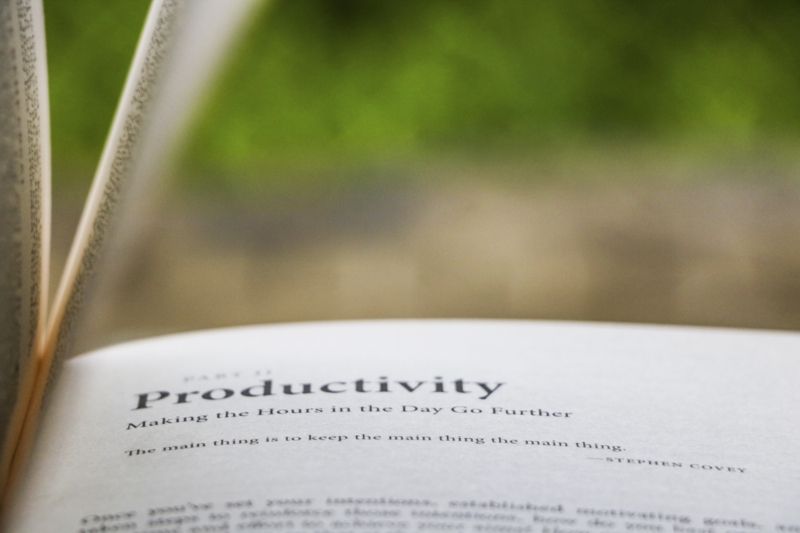How to Boost Your Productivity by Managing Your Time, Energy & Attention
RAFT Team, September 5, 2022
Most of us are headed back to work after a slower summer, and could probably use a refresher on getting things done to ensure we’re making the most of our time. Especially if you’re headed into Domestic Violence Awareness month (DVAM) preparations. Below you'll find a summary of an "Intro to Productivity" article from an expert so you can boost your productivity without downgrading your quality of life.
Productivity means managing your time well, yes, but also your energy, tasks, and attention. With so many things vying for every piece of your heart and mind, life can often feel like an endless maze you can’t seem to find your way out of. (Since starting this blog, I’ve had 2 different dogs need attention, a task list to convey to my son, lunch preparations to make, and a phone call to answer. None of us are immune to the pressures of interruptions or responsibilities.)
But we can have an easier time of it all, thanks to an excellent blog from Productive Flourishing. (You can read the complete article here.)
Notice What Takes Your Time, Energy, and Attention
One of the biggest takeaways from this productivity blog is understanding where your time and energy goes. Below is a list of questions. (I blitzed through them until I realized that a few notes would help me change my own time management. I encourage you to slow down enough to do the same.) This information will help you accurately estimate your time and your capacity and boost your productivity as a result.
- Gaining time: What are you doing that you could either stop doing or do more efficiently so that there’s less time seepage?
- Using time: What would you do with any additional time that you gain?
- Gaining energy: What could you do to increase your available emotional, social, mental, and physical energy?
- Losing energy: What are the sources of energy drain in your life? Is there something you can do to address those sources? It’ll probably take more energy to deal with the cause than the symptom, but continually applying Band-Aids has a cost, too.
- Gaining attention: What really engages you? What are you naturally drawn to do?
- Losing attention (aka being distracted): What’s distracting you or causing you to continually shift focus? Is there a way to alter your environment so you’re less prone to be distracted?
Be Specific
The second article takeaway is forcing yourself to be specific. What exactly are you trying to accomplish and how do you plan to get to completion? And even better, visualizing the outcome of your goals will help keep you motivated and focused, rather than running down rabbit trails of things not important to your overall goal.
- Visualize: Imagine the future state of the world you’ll bring about.
- Articulate: Clearly lay out what your goals are.
- Prioritize: Determine what is most important to you right now.
- Chunk: Break down the size of your projects into doable parts.
- Sequence: Put the projects’ chunks into a logical order.
Set SMART Goals
If you find yourself exhausted at the end of the day with more on your to-do list than when you started, the list below is for you. Once you know your goals and have made them specific, you can prioritize them using the 5 steps below. Your action list for DVAM month will be greatly simplified, and you’ll be able to see pretty quickly whether they’re realistic. You will probably be able to boost your productivity without spending more time.
- Simple: A goal is simple when you can look at it without wondering.
- Meaningful: A goal is meaningful when you understand why you’re completing that goal.
- Actionable: A goal is actionable when it’s clear what needs to happen to accomplish the goal.
- Realistic: A goal is realistic when the endpoint is achievable with the resources you have available.
- Trackable: A goal is trackable when it’s clear what progress means.
Categorize Your Task Levels
These 4 types of time blocks will help you establish a reasonable rhythm each week. All are necessary. (Don’t even think about skipping those recovery blocks!) Each time block takes different attention and energy. Introverts will need more energy for the social blocks, extroverts might need more energy to stay focused. Break down your “return from summer” catching up list and your DVAM to-do list and assigned each chunk to a block. This will help you maintain your energy much more easily.
- Focus blocks are 90–120 minute blocks of time where you’re especially creative, inspired, and able to do high-level work that requires focus.
- Admin blocks are 30–60 minute lower-energy blocks of time where you’re not in the zone to do the work that requires heavy lifting, but there are still other types of work you can do effectively.
- Social blocks are 90–120 minute blocks of time where you’re primed and energetically in the right space to meet with other people.
- Recovery blocks are variable-length blocks of time that you use for exercise, meditation, and self-care. Pro tip: Recovery looks different for everyone. Maybe recovering looks like reading a book, or maybe that means going to a party.
Write Great Tasks Lists
The last part of the Productive Flourishing article talks about creating effective, efficient task lists. Sound silly? Hang in there. It actually makes a lot of sense. Here’s our summary of take-aways from this section:
- Start each task with a verb. (Write, build, research, plan, coordinate, promote, review, schedule, etc.)
- Include all the information you’ll need to accomplish the task. Include emails, phone numbers, links to resources, or other details, so everything is at hand when it’s time for the task.
- Include any due dates. When is the task due? When is the project due? Who needs to be included in the loop and at what time?
- Be as clear as possible. Pretend you’re writing this for someone else. It’s easier to add details now as you write your task, then have to go searching for them later.
If you’re interested in really dialing things in so you can boost your productivity, spend some time reading the full article over on Productive Flourishing. While the front end may feel a bit like work, these new habits will keep you better rested and away from burnout.








